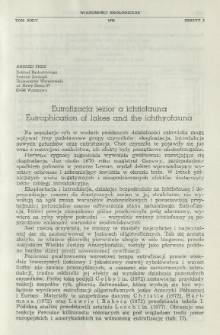- Search in all Repository
- Literature and maps
- Archeology
- Mills database
- Natural sciences
Advanced search
Advanced search
Advanced search
Advanced search
Advanced search

Object
Title: Eutrofizacja jezior a ichtiofauna
Subtitle:
Eutrophication of lakes and the ichthyofauna
Contributor:
Polska Akademia Nauk. Komitet Ekologii
Publisher:
Place of publishing:
Description:
Pages 201-208 ; 24 cm ; Bibliographical references (pages 207-208) ; Abstract in English
Type of object:
Abstract:
Papers by different authors have been used to compare examples of reaction of fish communities which seem to be the result of eutrophication of oligotrophic lakes iin Northern America and in Europe (Table I). The mechanisms and causes of such reactions as, e.g., better growth of some Salmonidae, higher infestation of fish by parasites, lesser ability for effective reproduction of species considered as typical for waters of a very low trophy, are discussed. Thus, possibilities of changes due to the increase of trophy are taken into consideration, namely the stratification pattern of fish communities, intra- and inter-specific relations of fish communities, efficiency of the influence of predators.The described by Colby et al. (1972) general relation between the size of catches and the species composition of a fish community and the degree of trophy, is presented (Fig. 1). Evidence is given that the curve illustrating this relation does not reflect the static system, but illustrates the dynamic, succesional sequence which is of course limited by the character of lake bed and drainage basin, The position of Polish lakes, where meso- and eutrophic water bodies dominate in the successional sequence presented is discussed. These lakes are dominated by Cyprinidae—Percidae. This community, although frequently less abundant ir. species, develops well even in shallow, highly polytrophic lakes. This shows that eutrophication of lakes of an intensity which does not disturb their natural development, i.e., does not lead to saprotrophy, is not yet dangerous for the existence of the majority of that community. To the contrary, in some mesotrophic lakes higher lertility, and thus more intense development of macrophytes, may provide better conditions for reproduction and existence for the majority of these fishes. However, it seems that already now the majority of Polish mesotrophic lakes either approaches or has attained the eutrophication level, which when surpassed would mean that further increase in trophy would not result in an increase of the total biomass of fishes (Table III).The situation of Coregoninae in Polish lakes is discussed stressing that despite the introductions the lake area in which they occur increases, but the number of lakes with autochthonous populations of these fish is smaller. This is usually caused by the fact that reproduction conditions in lakes become worse as the trophy increases.
Relation:
Volume:
Issue:
Start page:
End page:
Detailed Resource Type:
Resource Identifier:
oai:rcin.org.pl:156882 ; ISSN 0013-2969
Source:
MiIZ PAN, call no. P.3259 ; click here to follow the link
Language:
Language of abstract:
Rights:
Creative Commons Attribution BY 3.0 PL license
Terms of use:
Copyright-protected material. [CC BY 3.0 PL] May be used within the scope specified in Creative Commons Attribution BY 3.0 PL license, full text available at: ; -
Digitizing institution:
Museum and Institute of Zoology of the Polish Academy of Sciences
Original in:
Library of the Museum and Institute of Zoology of the Polish Academy of Sciences
Projects co-financed by:
Access:
Object collections:
- Repozytorium Cyfrowe Instytutów Naukowych > Kolekcje Partnerów > Muzeum i Instytut Zoologii PAN > Czasopisma
- Repozytorium Cyfrowe Instytutów Naukowych > Piśmiennictwo > Czasopisma/Artykuły
Last modified:
4 lut 2025
In our library since:
25 sty 2021
Number of object content downloads / hits:
63
All available object's versions:
https://rcin.org.pl./publication/112688
Show description in RDF format:
Show description in RDFa format:
Show description in OAI-PMH format:
| Edition name | Date |
|---|---|
| Z. 3. Eutrofizacja jezior a ichtiofauna / Prejs A. | 4 lut 2025 |
Objects Similar
Lewandowski, Krzysztof
Burchardt, Lubomira
Rybak, Jan Igor Węgleńska, Teresa
Kajak, Zdzisław
Gliwicz, Zbigniew Maciej
Hillbricht-Ilkowska, Anna
Prejs, Andrzej

 INSTYTUT ARCHEOLOGII I ETNOLOGII POLSKIEJ AKADEMII NAUK
INSTYTUT ARCHEOLOGII I ETNOLOGII POLSKIEJ AKADEMII NAUK
 INSTYTUT BADAŃ LITERACKICH POLSKIEJ AKADEMII NAUK
INSTYTUT BADAŃ LITERACKICH POLSKIEJ AKADEMII NAUK
 INSTYTUT BADAWCZY LEŚNICTWA
INSTYTUT BADAWCZY LEŚNICTWA
 INSTYTUT BIOLOGII DOŚWIADCZALNEJ IM. MARCELEGO NENCKIEGO POLSKIEJ AKADEMII NAUK
INSTYTUT BIOLOGII DOŚWIADCZALNEJ IM. MARCELEGO NENCKIEGO POLSKIEJ AKADEMII NAUK
 INSTYTUT BIOLOGII SSAKÓW POLSKIEJ AKADEMII NAUK
INSTYTUT BIOLOGII SSAKÓW POLSKIEJ AKADEMII NAUK
 INSTYTUT CHEMII FIZYCZNEJ PAN
INSTYTUT CHEMII FIZYCZNEJ PAN
 INSTYTUT CHEMII ORGANICZNEJ PAN
INSTYTUT CHEMII ORGANICZNEJ PAN
 INSTYTUT FILOZOFII I SOCJOLOGII PAN
INSTYTUT FILOZOFII I SOCJOLOGII PAN
 INSTYTUT GEOGRAFII I PRZESTRZENNEGO ZAGOSPODAROWANIA PAN
INSTYTUT GEOGRAFII I PRZESTRZENNEGO ZAGOSPODAROWANIA PAN
 INSTYTUT HISTORII im. TADEUSZA MANTEUFFLA POLSKIEJ AKADEMII NAUK
INSTYTUT HISTORII im. TADEUSZA MANTEUFFLA POLSKIEJ AKADEMII NAUK
 INSTYTUT JĘZYKA POLSKIEGO POLSKIEJ AKADEMII NAUK
INSTYTUT JĘZYKA POLSKIEGO POLSKIEJ AKADEMII NAUK
 INSTYTUT MATEMATYCZNY PAN
INSTYTUT MATEMATYCZNY PAN
 INSTYTUT MEDYCYNY DOŚWIADCZALNEJ I KLINICZNEJ IM.MIROSŁAWA MOSSAKOWSKIEGO POLSKIEJ AKADEMII NAUK
INSTYTUT MEDYCYNY DOŚWIADCZALNEJ I KLINICZNEJ IM.MIROSŁAWA MOSSAKOWSKIEGO POLSKIEJ AKADEMII NAUK
 INSTYTUT PODSTAWOWYCH PROBLEMÓW TECHNIKI PAN
INSTYTUT PODSTAWOWYCH PROBLEMÓW TECHNIKI PAN
 INSTYTUT SLAWISTYKI PAN
INSTYTUT SLAWISTYKI PAN
 SIEĆ BADAWCZA ŁUKASIEWICZ - INSTYTUT TECHNOLOGII MATERIAŁÓW ELEKTRONICZNYCH
SIEĆ BADAWCZA ŁUKASIEWICZ - INSTYTUT TECHNOLOGII MATERIAŁÓW ELEKTRONICZNYCH
 MUZEUM I INSTYTUT ZOOLOGII POLSKIEJ AKADEMII NAUK
MUZEUM I INSTYTUT ZOOLOGII POLSKIEJ AKADEMII NAUK
 INSTYTUT BADAŃ SYSTEMOWYCH PAN
INSTYTUT BADAŃ SYSTEMOWYCH PAN
 INSTYTUT BOTANIKI IM. WŁADYSŁAWA SZAFERA POLSKIEJ AKADEMII NAUK
INSTYTUT BOTANIKI IM. WŁADYSŁAWA SZAFERA POLSKIEJ AKADEMII NAUK




































